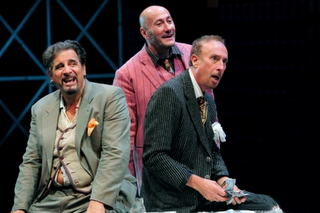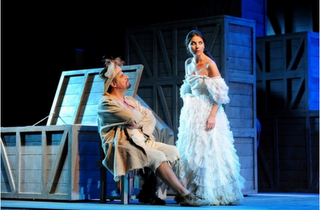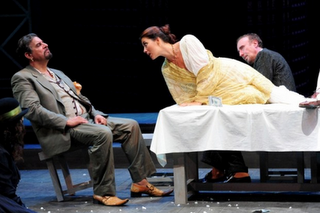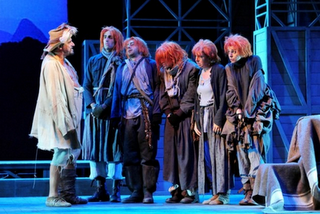 As usual once a year we organize a school trip toRome for our fourth year students to see one of Shakespeare’s plays at the theater (they have 16th /18th century literature in their syllabus). Each year we see a different play and this time I found that they had chosen one of my least favourite: “The Taming of the Shrew”. I didn’t mind the choice, it might actually come out as an occasion to re-read and re-evaluate this comedy which I had last seen on stage 5 years ago in an awkward, but not completely convincing, experiment of an all male company. This time it was different: mixed experienced cast, sparkling and vivacious staging, very good performances and brilliant direction (Armando Pugliese) plus excellent music (Goran Bregovic).
As usual once a year we organize a school trip toRome for our fourth year students to see one of Shakespeare’s plays at the theater (they have 16th /18th century literature in their syllabus). Each year we see a different play and this time I found that they had chosen one of my least favourite: “The Taming of the Shrew”. I didn’t mind the choice, it might actually come out as an occasion to re-read and re-evaluate this comedy which I had last seen on stage 5 years ago in an awkward, but not completely convincing, experiment of an all male company. This time it was different: mixed experienced cast, sparkling and vivacious staging, very good performances and brilliant direction (Armando Pugliese) plus excellent music (Goran Bregovic). The play
In "The Taming of the Shrew", once again , Shakespeare chooses a
fictional Italian setting, Italy which he completely reinvents and could well be any place in the world if not England itself. But the scene is actually set in a gypsy camp in Pugliese's version. However, in Padua, swashbuckler Petruchio carries out his brawny courtship of Katherine, the elder daughter of wealthy Baptista Minola, who is certainly very beautiful but also rough, rude and vulgar, the “shrew” of the title. Petruchio longs for her father’s money and is also stimulated by the challenge Katherine sets to his manhood: he must tame and marry her.
 The Taming of the Shrew is one of Shakespeare’s earliest comedies, and it shares many essential characteristics with his other romantic comedies, such as Much Ado About Nothing and A Midsummer Night’s Dream. These elements include lighthearted humour, disguise and deception, and a happy ending in which most of the characters come out satisfied. The lightheartedness of these romantic comedies contrasts sharply with the darker humor and deeper characterization of Shakespeare’s later plays, both comic and tragic.
The Taming of the Shrew is one of Shakespeare’s earliest comedies, and it shares many essential characteristics with his other romantic comedies, such as Much Ado About Nothing and A Midsummer Night’s Dream. These elements include lighthearted humour, disguise and deception, and a happy ending in which most of the characters come out satisfied. The lightheartedness of these romantic comedies contrasts sharply with the darker humor and deeper characterization of Shakespeare’s later plays, both comic and tragic.  A play focusing on the concerns of married life would have seemed particularly relevant to English audiences of the Renaissance period. Theirs was a society concerned with marriage in general, thanks in part to Henry VIII’s separation of England from the Catholic Church in 1534 in order to secure a divorce that the pope had refused to grant him. Henry’s troubles highlight one important aspect of Elizabethan marriages among the upper class: they were most often arranged for money, land, or power, rather than for love. Furthermore, unless you were the king of England, the late sixteenth and early seventeenth centuries offered few ways out of an unhappy marriage. So, the resolution of marital disputes became an important topic in the popular literature of the era.
A play focusing on the concerns of married life would have seemed particularly relevant to English audiences of the Renaissance period. Theirs was a society concerned with marriage in general, thanks in part to Henry VIII’s separation of England from the Catholic Church in 1534 in order to secure a divorce that the pope had refused to grant him. Henry’s troubles highlight one important aspect of Elizabethan marriages among the upper class: they were most often arranged for money, land, or power, rather than for love. Furthermore, unless you were the king of England, the late sixteenth and early seventeenth centuries offered few ways out of an unhappy marriage. So, the resolution of marital disputes became an important topic in the popular literature of the era. By modern readers and audiences, The Taming of the Shrew has always been seen as a controversial play, especially for its idea of the domestication of the woman as the taming of a wild animal. This idea has been considered unacceptable and offensive and Shakespeare, depicting the victory of a chauvinistic and overbearing man over a woman rebelling and fighting for her freedom, has been labeled as a chauvinist himself.
By modern readers and audiences, The Taming of the Shrew has always been seen as a controversial play, especially for its idea of the domestication of the woman as the taming of a wild animal. This idea has been considered unacceptable and offensive and Shakespeare, depicting the victory of a chauvinistic and overbearing man over a woman rebelling and fighting for her freedom, has been labeled as a chauvinist himself.I particularly liked the fact that director Armando Pugliese tried to give this comedy a different approach. First of all he doesn’t cut off, as it often happens, the frame story introducing Christopher Sly, the poor drunk tinker tricked by a group of lords who make him believe he’s extremely rich and make him watch the staging of “The Taming of the Shrew” as a gift or a trick.
 The frame story hasn’t got an explanation or an end in Shakespeare - where there is no epilogue after Katherine's surrender - but it has in Pugliese’s staging. The story has , in fact, been slightly changed. Dressed in fine clothes, Sly falls asleep in the elegant residence he believes his own, while waiting for the company of actors to perform a play for him. He sleeps and in his dreams he is Petruchio and “The Taming of the Shrew” is ... what happens in his dream. When he wakes up, at the end of the play, while Kate and Petruchio finally get to their marital bed, he is welcome back by his strong, harsh wife who reminds him who he really is , ridicules him as the poor drunkard he has always been, and pushes him around. Petruchio has only dreamt of taming Katherine!
The frame story hasn’t got an explanation or an end in Shakespeare - where there is no epilogue after Katherine's surrender - but it has in Pugliese’s staging. The story has , in fact, been slightly changed. Dressed in fine clothes, Sly falls asleep in the elegant residence he believes his own, while waiting for the company of actors to perform a play for him. He sleeps and in his dreams he is Petruchio and “The Taming of the Shrew” is ... what happens in his dream. When he wakes up, at the end of the play, while Kate and Petruchio finally get to their marital bed, he is welcome back by his strong, harsh wife who reminds him who he really is , ridicules him as the poor drunkard he has always been, and pushes him around. Petruchio has only dreamt of taming Katherine! Another main change is in the tone with which Vanessa Gravina interprets Katherine’s final monologue, the long soliloquy marking the "shrew" ’s surrender to the superiority of her husband, her acceptance of the given roles. It is conveyed that Katherine accepts to give in but meditates her vengeance at the same time, she bends to react: there’s so much in the trembling irony of her tone while pronouncing those well-known words: she is only pretending obedience. Another interesting change: Bianca the sweet, romantic, obedient younger sister who marries Lucentio, not only betrays her father’s trust eloping with her lover or disobey her newly married husband , she even tranforms herself into a rough, rude, vulgar girl, a copy of her sister before marriage.Shakespeare (not only in this staging) doesn’t seem to trust women very much. They are smart subtle pretenders. They are good at disguise and playing tricks, and their ability at using make-up is the sign of their skills. Never believe in appearances!
Another main change is in the tone with which Vanessa Gravina interprets Katherine’s final monologue, the long soliloquy marking the "shrew" ’s surrender to the superiority of her husband, her acceptance of the given roles. It is conveyed that Katherine accepts to give in but meditates her vengeance at the same time, she bends to react: there’s so much in the trembling irony of her tone while pronouncing those well-known words: she is only pretending obedience. Another interesting change: Bianca the sweet, romantic, obedient younger sister who marries Lucentio, not only betrays her father’s trust eloping with her lover or disobey her newly married husband , she even tranforms herself into a rough, rude, vulgar girl, a copy of her sister before marriage.Shakespeare (not only in this staging) doesn’t seem to trust women very much. They are smart subtle pretenders. They are good at disguise and playing tricks, and their ability at using make-up is the sign of their skills. Never believe in appearances!We saw The Taming of the Shrew at Teatro Quirino, Rome, on Thursday afternoon, December 15. See the official site The cast: Vanessa Gravina (Caterina), Edoardo Siravo (Christopher Sly, Petruccio), Giulio Farnese (Battista), Carlo di Maio ( Gremio, il sartore) , Vito Facciolla (primo servo, Grumio) , Gianluca Enria (capocomico, Nicola, pedante, Vincenzo), Elisabetta Alma (ostessa, Curzia), Emanuela Trovato (Bianca), Alberto Caramel (Ortensio), Stefano Vona Bianchini (Tranio, Giuseppe) , Maurizio Tomacello (Lucensio, terzo servo, Filippo), Valentina D'Andrea ( secondo servo, Pandora, la vedova).
Before watching the play at the theatre, we had some interesting lessons reading from the play and about the play, seeing scenes from Zeffirelli's film with Elizabeth Taylor and Richard Burton (1967) and from BBC Shakespeare Re-told, The Taming of the Shrew (2005), with Shirley Henderson and Rufus Sewell. Tomorrow we'll have a final discussion on some of the themes and motifs.

